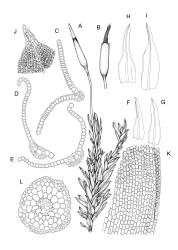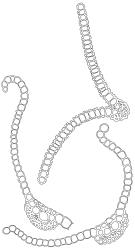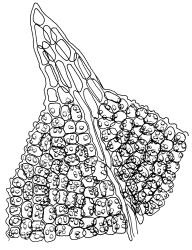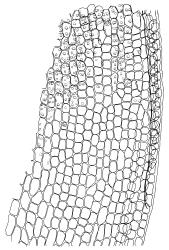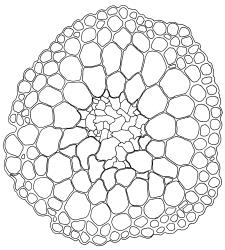- = Tortula flavinervis var. obscura Dixon in Dixon & Bartram, Bot. Not. 1937: 75 (1937)
- ≡ Barbula pseudopilifera var. obscura (Dixon) Sainsbury, Rev. Bryol. Lichénol., n.s. 21: 217 (1952)
- ≡ Pseudocrossidium crinitum var. obscurum (Dixon) B.H.Macmill. & Fife in Fife, Bryologist 98: 315 (1995)
Plants yellow-green above, brown below, usually forming dense turves. Stems 5–30 mm, in cross-section with a central strand and a weakly developed sclerodermis. Leaves erect-spreading to spreading when moist, individually strongly twisted and often twisted around the stem when dry, 1.6–2.0 mm, lingulate to oblong-lanceolate, carinate, broadly acute to obtuse; margins recurved in basal ⅔, crenulate-papillose; upper laminal cells obscure, quadrate to short-rectangular, some oblate, thin- to firm-walled, evenly thickened, pluripapillose with complex papillae, (7.0–)7.5–10.5(–13) × (7.5–)9–10.5(–12) µm, becoming longer and wider towards the base; upper marginal cells not differentiated; lower laminal cells not conspicuously differentiated, gradually transitioning from upper laminal cells, rectangular, thin- to firm-walled, papillose, smooth in the extreme base only, several rows quadrate at the margin and forming a weak border. Costa stout, concolorous, excurrent as a sometimes recurved short or long cusp, sunken in a deep groove adaxially; adaxial superficial cells long-rectangular, smooth with patches of quadrate papillose cells; abaxial superficial cells long-fusiform throughout, finely papillose in distal ½ to ⅔. Rhizoidal tubers not seen in N.Z. material. Laminal KOH colour reaction yellow.
Perichaetia with leaves little differentiated (neither sheathing nor convolute), erect-spreading, innermost longer than vegetative leaves, (2.0–)2.5–3.0(–3.6) mm, with basal hyaline, rectangular cells extending ⅓ to ½ of leaf length. Perigonia not seen in N.Z. material. Setae slender, orange-red to dark purple-black below, paler above, 6–10 mm. Capsules erect, asymmetric, subcylindric, widest near base and tapering to the mouth, red-brown, darker at the mouth, 1.6–2.4 mm. Operculum long-conic, ½ to equalling the theca length, with cells spirally arranged. Peristome c. 0.8 mm, light brown-pink, of 32 spiralled filiform rami, densely spiculose, weakly articulate, twisted several times to the right from a very low basal cylinder. Spores 11–14 µm, smooth.
Crum & Anderson 1981, fig. 153, a–g; Smith 2004, fig. 95, 8–12; Porley 2008, pp. 72–73; Lüth 2019, p. 580; Malcolm et al. 2020, pp. 493–495.
Barbula unguiculata can be recognised in the field with a hand-lens by its yellowish colour, and by the costa, pale and sunken on the adaxial leaf surface, and excurrent in a sometimes recurved cusp. The most likely confusion is with Gertrudiella torquata, which may have a very similar appearance, both wet and dry, but the pale costa (due to smooth, hyaline, adaxial superficial cells) of B. unguiculata will distinguish it from G. torquata. Further distinguishing features are given under the latter species. Species of Trichostomum and Weissia, taxa which also have the costa shortly excurrent, may be distinguished by their plane or incurved leaf margins (vs margins recurved in Barbula unguiculata) and by their elongate, hyaline, and lax lower laminal cells (vs scarcely differentiated lower laminal cells in Barbula unguiculata). Depauperate forms of Pseudocrossidium crinitum may be distinguished from Barbula unguiculata by their shorter laminal cells, 7.5–10.5 µm in length (vs 12–16 µm in Barbula unguiculata).
NI: N Auckland, including offshore islands (LB, RT), S Auckland, Gisborne, Hawke’s Bay, Taranaki, Wellington; SI: Nelson, Marlborough, Canterbury, Otago.
Adventive. Widespread in the northern hemisphere. Recorded for mainland Australia (Streimann & Klazenga 2002), Tasmania (Dalton et al. 1991), Chile (He 1998), and Peru (Menzel 1992).
Usually occurring on soil, but also on concrete and volcanic rock. Commonly on roadsides, or colonising bare patches in lawn or in rough pasture. Records range from near sea level to 800 m (Kyeburn River, Otago L.D.). The species has been recorded with a wide range of other mosses, including Ceratodon purpureus, Fissidens leptocladus, Funaria hygrometrica, Gertrudiella torquata, Grimmia pulvinata, Gymnostomum calcareum, Tortula muralis, and Trichostomopsis australasiae.
Barbula unguiculata was first recognised in N.Z. by Sainsbury (1955), albeit tentatively. He had submitted to H.N. Dixon a sterile specimen (Maunganui, Tauranga, E.A. Hodgson 755, (G.O.K. Sainsbury to H.N. Dixon 968), Sep. 1940, BM 001006732, WELT M011168, M029572, CHR 568277), which Dixon considered to be new, tentatively proposing the name Barbula subglaucula sp. nov. Dixon commented that it was remarkably like B. unguiculata and very near the Victorian B. glaucula Broth. (see Sainsbury 1955, p. 167). Sainsbury had in his herbarium another gathering, also sterile, from near Wairoa (M.D. Sainsbury s.n., 16 Dec. 1951, WELT M029580, M011170). Much earlier N.Z. specimens of B. unguiculata have now been found in herbaria under other names, namely a specimen that is the type of Tortula flavinervis var. obscura (Lyttleton, S. Berggren 2413, Apr. 1875, BM 000825921, WELT M001015), and another in the herbarium of Charles Knight (WELT-Knight M044544), named as Tortula crispifolia (a species now synonymised with Gertrudiella torquata). This latter specimen is copious and fruiting, and although the provenance and precise collection date are unknown (collection dates for some other mosses in Knight’s herbarium lie between 1870 and 1874), it would appear that this putatively introduced species may have been well established by that time.




